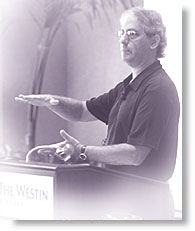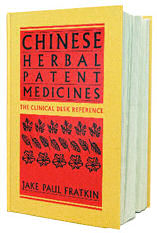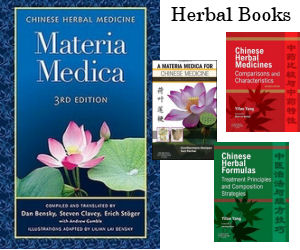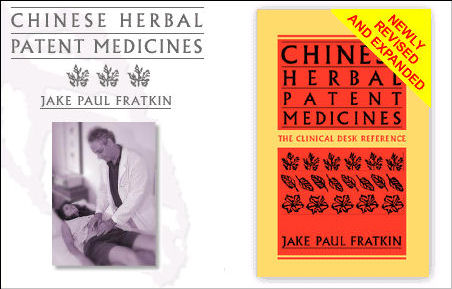Acupuncture & TCM Articles

Articles by Jake Paul Fratkin, OMD, LAc
Jake Fratkin, OMD, LAc, has been in the practice of Oriental medicine since 1978. Following undergraduate and graduate training at the University of Wisconsin in Chinese language and philosophy and pre-medicine, he pursued a seven-year apprenticeship in Japanese and Korean style acupuncture with Dr. Ineon Moon and a two-year apprenticeship in Chinese herbal medicine with Drs. Zhengan Guo and Pak-Leung Lau in Chicago. He also spent a year in Beijing hospitals interning in advanced herbal medicine, specializing in gastrointestinal and respiratory disorders, and pediatrics.  Dr. Fratkin is the author of several books, including Chinese Herbal Patent Medicines: The Clinical Desk Reference, and is the editor-organizer of Wu and Fischer's Practical Therapeutics of Traditional Chinese Medicine. In 1999, he was named the "Acupuncturist of the Year" by the American Association of Oriental Medicine.
Dr. Fratkin is the author of several books, including Chinese Herbal Patent Medicines: The Clinical Desk Reference, and is the editor-organizer of Wu and Fischer's Practical Therapeutics of Traditional Chinese Medicine. In 1999, he was named the "Acupuncturist of the Year" by the American Association of Oriental Medicine.
Chinese Herbal Patent Medicines: The Clinical Desk Reference
Hardback book, 1198 pages. This volume covers 1360 products, including 550 GMP level products and all of California FDB analysis on 505 products. Includes information on endagered animals, heavy metals, and pharmaceuticals. The text is organized into 12 groups, with a total of 109 chapters and includes material by Andrew Ellis, Subhuti Dharmananda, and Richard Ko. Over 80 pages of full-color photos (with English and Chinese cross-reference). Fully indexed.
Scientific Criticism of Traditional Oriental Medicine: Reflections Following Conversations With My Twin Brother
Several years ago, I joined my twin brother Elliot in northern Kenya for two weeks. He is a PhD anthropologist, head of the department as Smith College, and an expert on East African pastoral tribes.
During this time, we had some interesting conversations around his criticisms that Oriental medicine is not “scientific.’ In deciding to write this article, I asked Elliot for clarification of his criticisms, and he provided the following:
"I am not an not an expert on either Chinese medicine or Western medicine; I am an anthropologist who studies African pastoralists. I do not claim to speak for Western medical science, but I do advocate a scientific approach to studying objective phenomena. Science is seeking truth or knowledge about phenomena based on empirical observation, testing hypotheses with physical evidence, and so on. This is in opposition to belief, which relies on a faith in a dogma rather than testing. I am not saying here that Chinese traditional medicine is a faith, a belief, or a religion; I am enough of an anthropologist to recognize it as an indigenous medical system. But I am critical that many of the statements of traditional practitioners are not always based on hard evidence."
He went on to say, "I believe some acupuncture treatments and Chinese herbal medicines are effective for some disorders, although not as broadly as claimed by its practitioners. What I don't like is the nonscientific explanation used by traditional practitioners when describing their efficacy, such as ‘qi energy,´ ‘acupuncture channels´ or the relation of ‘yin and yang´ as mechanisms of physiology. Why do you need explanations that are based on belief rather than from known or observable principles of physiology including biochemical reactions in the body? How do you observe or measure qi energy?
"You say clinical observations 'prove' the efficacy of traditional medicine, that these treatments have been used for thousands of years. While I agree clinical observations are certainly important in medicine, there is no way of really knowing if something is effective or not without double-blind studies. For example, a person may suffer local back pain and seek treatment from acupuncture, Chinese herbs, African herbs, vitamin E, antibiotics, massage, steroid injections, or even prayer. The person may indeed recover or heal after any of these measures, but this in itself is not proof that any of these measures work. You need clinical trials of statistically significant samples of a population, with a controlled sample (who are not treated or given a placebo) to see which of these treatments worked.
"Moreover, you need further investigation to explain the mechanisms of how these treatments work, if possible. For example, acupuncture works as a painkiller under controlled studies. But unless you study all of these health interventions of Oriental medicine with the same rigor, you will not truly know which ones really work. Until I can see rigorous medical testing of alternative therapies, I cannot accept at face value assertions that they are effective."

Elliot's argument is succinct, pointed, and representative of many in the scientific and medical communities. It certainly provoked thoughts and reactions on my own part, and I must conclude that Elliot is right. Oriental medicine as it is practiced is not scientific medicine. It is something very different, certainly a medical art, but certainly not dependent upon or based upon modern science. It may come to pass that science will validate the effectiveness and mechanisms of acupuncture and herbal medicine, but that research will not come quickly or easily.
I have several concerns with Elliot's argument. Oriental medicine is an extremely old and time-tested medicine, with very specific energetic language to guide its practice. If we look at it only through the prism of that which has been scientifically validated, we would lose the art. Presently, the only aspect of Oriental medicine that has been scientifically explained in the West has been the mechanisms of pain control. Should we limit our art only to this?
Secondly, Oriental medicine treats disease and injury in radically different ways than Western medicine, and, in my opinion, is superior to Western medicine in many clinical respects. To merge it or subordinate it within scientific confines would, again, lose the art. We cannot allow Oriental medicine to be explained only by a biochemical or physiological model. Its efficacy is based on manipulation and enhancement of qi and blood, and regulation of the zang-fu organs. We need to defend the philosophical integrity of Oriental medicine as a separate medical art with its own rationale, based on energetic physiology. We welcome scientific validation, but patients in need should not be required to wait for it.
Elliot's criticisms of Oriental medicine can be reduced to three problems: an archaic nonscientific language, lack of double-blind placebo studies for validation, and lack of a modern scientific explanation of how it works. I would like to address these one by one.
1. The Use of Archaic Nonscientific Language
Although originally a science of anatomy, Western medical science has developed into a science of biochemical and cellular physiology. The energetic framework of Oriental medicine does not fit within the intellectual matrix that directs Western medical thinking.
This is not to fault medical science, but it is limited. Oriental medicine is based on energetic physiology, the knowledge that energetic forces within the body control biochemical and cellular activity, that it provides the electric forces that dictate biochemical and cellular activity. How do we know this? Because when we manipulate bioenergy through acupuncture, biochemical changes occur.
We use the words yin, yang and qi not only to be loyal to an older tradition, but because our medical art requires these terms for correct and effective therapy. Acupuncture and herbal medicine cannot be used correctly if we only talk about them in terms of biochemical physiology. By describing the nature of a problem in terms of energetic imbalance, the traditional language dictates the necessary therapy with acupuncture or herbal medicine. If we abandon the energetic language to Western scientific language, we sacrifice the effectiveness of the therapy.
To a Western doctor using acupuncture from a Western perspective, one can look at the research of Bruce Pomerantz (an MD and Harvard-trained PhD) who refers to endorphin releases and neurovascular effects after stimulation by deep needle insertion. This justifies acupuncture for pain control, and certainly provided the evidence to the National Institute of Health (NIH) that recently brought acupuncture into the medical mainstream. This level of medical acupuncture does not require knowledge of yin, yang and qi. As a method of neural-vascular stimulation, however, it is not very different from other techniques such as saline injection of trigger points. (In Dr. Pomerantz's defense, he is quoted as saying, "I spent the last 25 years proving that acupuncture controls pain. I hope to spend the next 25 years proving that acupuncture promotes healing.")
The more subtle schools of acupuncture, however, require energetic terminology if there is to be clinical effectiveness. In the meridian balancing school that I practice (based on meridian therapy, with Fukishima and Shudo being the best known of its proponents), we are required to bring yin and yang channels into energetic balance. This is determined primarily by pulse diagnosis, with the deeper portion of the radial artery being the yin aspect and the superficial portion of the pulse being the yang aspect. When we divide the radial pulse into three positions and say that they represent different acupuncture channels, this is not just an archaic description from the Nanjing. It is a modern requirement for effective therapy.
For example, let us suppose that a patient comes to us with symptoms of abdominal cramping with headache. In taking the pulse, we find that the gallbladder position is excess and the liver and spleen positions are deficient. This pulse diagnosis tells us which points to choose and how to treat them, in this case choosing to drain GB 38 while tonifying Liv 3 and Sp 3. If our point selection and needle technique are correct, the pulse will change immediately and discernible symptoms such as headache will significantly subside.
As we observe positive changes in the pulse and symptoms, we know our energetic diagnosis is correct. This is the proof of the validity of our descriptive language; it is our scientific cause and effect. We could not change this symptom picture merely by inserting needles into deep-tissue neurovascular bundles, especially when you consider that the needle technique was performed at less then 2mm insertion.
Energetic terminology is equally important in the field of Chinese herbal medicine. If we took a phlegm cough as an example and had only Western science to explain the mechanism, we would be at a loss as to which Chinese herbs to choose. Certain herbs might be documented in the Western literature as having an antitussive effect, perhaps relaxing bronchial spasm, inhibiting microbial infection, etc. But our medicine, our science, demands energetic terminology in order to choose the correct herb or herbal combination. The starting place is etiology, and cough may be due to lung dryness, excess damp, excess heat or fire, exogenous cold that has entered the lung, or the presence of heat toxins. If we decide the cough is due to exogenous cold, we must choose herbs or prescriptions that dispel wind cold. If we have a dry cough, we must choose herbs that moisten lung yin. Our proof, our validation, happens every time we correct a symptom or problem because we accurately determined the energetic etiology and presentation. By knowing the cause and presentation within our descriptive language, we are able to provide the required remedy.
2. The Lack of Double-Blind Placebo Studies
To address Elliot's concerns of double-blind studies, I can't think of any medically astute TCM practitioner who is opposed to these. The problem here is logistical. Double-blind studies are expensive, and until recently our government has not funded any. The National Institutes of Health (NIH) is now offering $55 million a year for all studies in alternative medicine, a nice start but a drop in the bucket as far as federally funded research goes. Private industry, the mainstay behind double-blind studies for potential pharmaceuticals, only funds projects that may prove to be financially rewarding. They have no interest in proving the efficacy of acupuncture or herbal medicine, especially when the results could impinge on the commercial viability of their products.
Modern China has done an enormous amount of research on Oriental medicine during the last 50 years using human, animal and in vitro studies. Pomerantz mentions that only half of that research would hold up to American standards, and without duplicating the studies, you really don't know which half they are. Also, China will not do double-blind placebo studies because the Chinese feel it is unethical to deny a sick person some form of treatment. They will test a new formula or acupuncture procedure by itself ("87% showed marked improvement in 10 days"), or they will compare the result against an established Oriental or Western protocol (50% were given antibiotics, 50% were given the new formula, and results were …").
Many participants in the Western sciences would suspend any clinical application of acupuncture and herbal medicine until scientific studies validated their efficacy. Imagine such a scenario. It took NIH and the FDA 25 years to approve acupuncture as an acceptable procedure. How many patients were successfully treated during the last 25 years prior to NIH/FDA approval? What positive impact has Oriental medicine had on health care in this country during that time?
Are double-blind placebo studies the best scientific approach for acupuncture? How many surgical procedures have undergone double-blind placebo studies? Surely there are other scientifically acceptable models for evaluating a procedure's effectiveness.
3. The Lack of a Modern Scientific Explanation
While one can argue the value of double-blind studies, Elliot's argument requiring a Western scientific explanation of the mechanisms of acupuncture is on shaky ground. This may help the intellectual comfort level of certain doctors and scientists, but certainly does not seem to be a requirement in establishing new therapies in Western medicine. How many Western pharmaceuticals have their method of action satisfactorily explained? Aspirin, in use for 100 years, only recently had its physiological mechanism explained. Because Western medicine employs the language of biochemical physiology, it is unable to understand the mechanisms utilized in acupuncture energetics, such as qi, yang and yin, and acupuncture channels. I believe that science, as the technology improves, will validate acupuncture on its own terms. Scientific instruments will not only perceive, record, and describe qi, but also discern a difference between yin and yang energy, see the rotation of qi through the channels, and quantify the dissemination of qi into surrounding tissue with various kinds of acupuncture stimulation. This kind of science is already being done in China, Japan, Russia and Germany, but unfortunately, American scientists only trust and look at American research.
Describing the effects of Oriental medicine in terms of physiology is not the same as offering a scientific explanation. Observing the release of endorphins with acupuncture stimulation does not describe its method of action, only one of its consequences. There may be hundreds of chemical actions that occur because of acupuncture stimulation; because they are not observed or documented does not mean that they have not occurred. By the same thinking, because energetic pathways, qi, yin and yang have not been observed scientifically, does not mean that they do not exist. The technology exists to do so, and needs to be explored.
4. The Relationship of Oriental Medicine to Western Medicine
Western medicine and Oriental medicine have entirely different orientations in treating illness and injury, and as such, need to be taught and maintained as separate medical arts. Western medicine in the main seeks to control uncomfortable or dangerous symptoms based on observation and manipulation of biochemical mechanisms, regardless of the harshness of the medicines. By focusing narrowly on disease manifestations, they have lost sight of a unified overview of health and vitality. Oriental medicine starts from the posture of what a healthy body should be, describing the free circulation of qi and blood through defined channels as well as organ function according to zang-fu energetic physiology. It manipulates natural mechanisms of regeneration and recuperation quickly, clearly and without side-effects when performed by a trained practitioner.
I am not opposed to science, and it is obvious that the effectiveness of Western medicine is dependent upon it. Nor am I opposed to Western medicine. It excels at crisis management for the injured, the hospitalized and the dying, and in the next 30 years it will provide the benefits of genetic manipulation for conditions like juvenile diabetes and cystic fibrosis. Oriental medicine, on the other hand, excels at treatment of non-crisis illness and injury by accelerating the healing process.
This difference between Western and Oriental medicine points out the need to keep the two arts separate, both in education and clinical autonomy. To merge them intellectually would only diminish the effectiveness of each separate art. Subjecting Oriental medicine to the rigors of modern science is excellent for validating its techniques and efficacy, but to accept Oriental medicine only from the viewpoint of modern science is to diminish an ancient and powerful medicine. Its efficacy is dependent on its application according to traditional methodology, language, and understanding of the body. Clinics and hospitals should offer both kinds of treatment, without one trying to control or dictate terms to the other. The future requires an informed public that has equal access to both kinds of treatment. This is the case today in China, where both types of medicine compete equally for over one billion patients.
 
|
